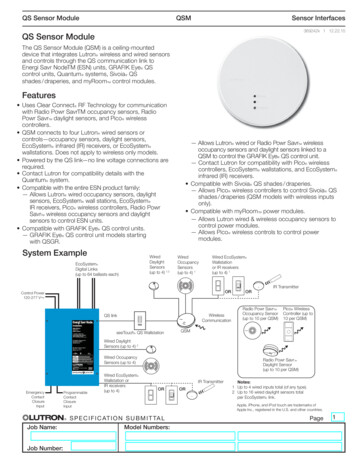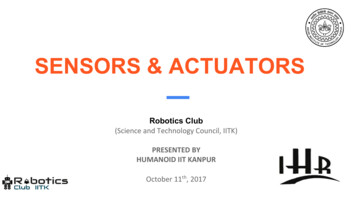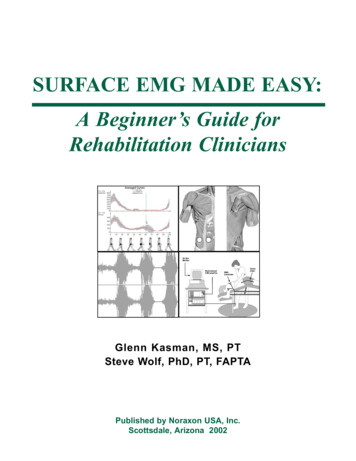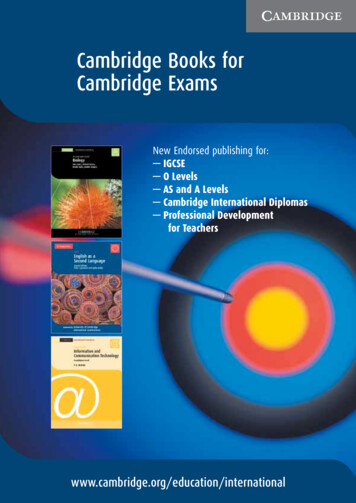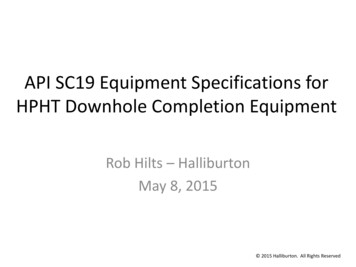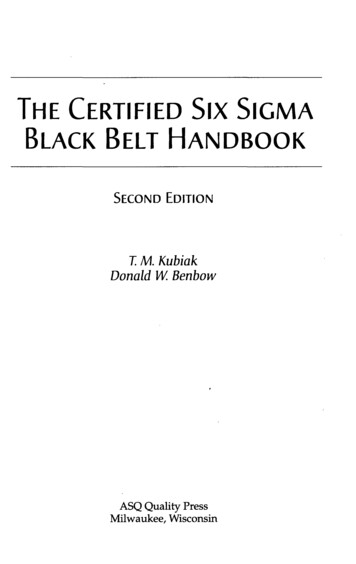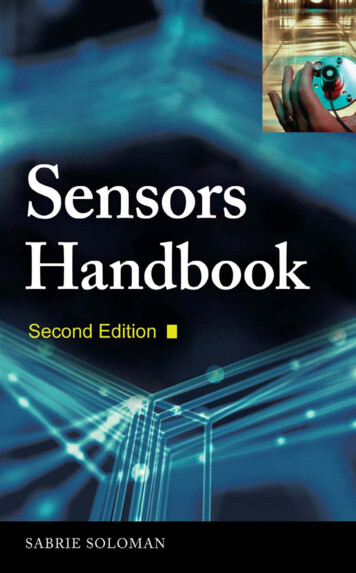
Transcription
SENSORSHANDBOOKSabrie Soloman, Ph.D., Sc.D., MBA, PEChairman and CEO American SensoRx, Inc., USAProfessor, Founder, Advanced Manufacturing Technology,Columbia University, USAChairman and CEO, SensoRx, Chongqing, Ltd., China.Second EditionNew York Chicago San Francisco Lisbon London MadridMexico City Milan New Delhi San Juan SeoulSingapore Sydney Toronto
Copyright 2010, 1999 by The McGraw-Hill Companies, Inc. All rights reserved. Except as permitted under theUnited States Copyright Act of 1976, no part of this publication may be reproduced or distributed in any form or byany means, or stored in a database or retrieval system, without the prior written permission of the publisher.ISBN: 978-0-07-160571-7MHID: 0-07-160571-1The material in this eBook also appears in the print version of this title: ISBN: 978-0-07-160570-0,MHID: 0-07-160570-3.All trademarks are trademarks of their respective owners. Rather than put a trademark symbol after every occurrenceof a trademarked name, we use names in an editorial fashion only, and to the benefit of the trademark owner, withno intention of infringement of the trademark. Where such designations appear in this book, they have been printedwith initial caps.McGraw-Hill eBooks are available at special quantity discounts to use as premiums and sales promotions, or for usein corporate training programs. To contact a representative please e-mail us at bulksales@mcgraw-hill.com.Information contained in this work has been obtained by The McGraw-Hill Companies, Inc. (“McGraw-Hill”) fromsources believed to be reliable. However, neither McGraw-Hill nor its authors guarantee the accuracy or completeness of any information published herein, and neither McGraw-Hill nor its authors shall be responsible for any errors,omissions, or damages arising out of use of this information. This work is published with the understanding thatMcGraw-Hill and its authors are supplying information but are not attempting torender engineering or other professional services. If such services are required, the assistance of an appropriate professional should be sought.TERMS OF USEThis is a copyrighted work and The McGraw-Hill Companies, Inc. (“McGraw-Hill”) and its licensors reserve allrights in and to the work. Use of this work is subject to these terms. Except as permitted under the Copyright Act of1976 and the right to store and retrieve one copy of the work, you may not decompile, disassemble, reverse engineer,reproduce, modify, create derivative works based upon, transmit, distribute, disseminate, sell, publish or sublicensethe work or any part of it without McGraw-Hill’s prior consent. You may use the work for your own noncommercialand personal use; any other use of the work is strictly prohibited. Your right to use the work may be terminated if youfail to comply with these terms.THE WORK IS PROVIDED “AS IS.” McGRAW-HILL AND ITS LICENSORS MAKE NO GUARANTEES OR WARRANTIES AS TO THE ACCURACY, ADEQUACY OR COMPLETENESS OF OR RESULTS TO BE OBTAINEDFROM USING THE WORK, INCLUDING ANY INFORMATION THAT CAN BE ACCESSED THROUGH THEWORK VIA HYPERLINK OR OTHERWISE, AND EXPRESSLY DISCLAIM ANY WARRANTY, EXPRESS ORIMPLIED, INCLUDING BUT NOT LIMITED TO IMPLIED WARRANTIES OF MERCHANTABILITY OR FITNESS FOR A PARTICULAR PURPOSE. McGraw-Hill and its licensors do not warrant or guarantee that the functions contained in the work will meet your requirements or that its operation will be uninterrupted or error free.Neither McGraw-Hill nor its licensors shall be liable to you or anyone else for any inaccuracy, error or omission,regardless of cause, in the work or for any damages resulting therefrom. McGraw-Hill has no responsibility for thecontent of any information accessed through the work. Under no circumstances shall McGraw-Hill and/or its licensors be liable for any indirect, incidental, special, punitive, consequential or similar damages that result from the useof or inability to use the work, even if any of them has been advised of the possibility of such damages. This limitation of liability shall apply to any claim or cause whatsoever whether such claim or cause arises in contract, tort orotherwise.
To My BelovedsHer hovering soul is as a lily, majestically floating on water embracing the morning dew—quenching my thirst, collecting the morning sun in the basket of her illuminating righteousness enlightening my eyes—to the noble one, and to her cherished offspring. The work ofthis handbook is dedicated, to my beloveds—wife and son Elvira and Stephan.To My MentorsThe humble work of this handbook is contributed to my mentors in my childhood andadulthood alike. During my childhood, both my father and mother—Dr. Barsoum andMrs. Zahia Soloman, who departed this earth in perfect glory and full honor—selflesslygave themselves unceasingly to my modest beginning, and their memory never fails toseize the uppermost of my intellect. The echo of their voice still resonates through my soul,remembering their words of wisdom and courage. Although a great deal of their teachingswere dedicated toward acquiring the knowledge for science and innovation, yet their fewdivine words about Christ, the founder of science, and the creator of the universe made meembrace the ideology of creation and accept the Christian faith eternally.Similarly, my brother Dr. Nasier Soliman and my sister-in-law Mrs. Anne Soliman havepermeated in me the spirit of permutation and brought forth the hidden wealth of knowledge that I unknowingly possessed. My parents had instilled in me the desire to follow theirfootsteps for a short period, only to teach me how to bypass them. Similarly, and in the fullness of time, I found my brother Nasier and my sister-in-law Anne, are selflessly paving thepath of my success by their dedicated advice and waving care. Their perpetual encouragements have set the course of my advancements to leap forward in spite of limitations.Indeed, the loving living example of my parents will always live on, through me, mycorporate staff, my students, and my students’ students.
ABOUT THE AUTHORSabrie Soloman, Ph.D., Sc.D., MBA, PE, is the Founder, Chairman,and CEO of American SensoRx, Inc., and SensoRx, Chongqing,China, Ltd. He is a professor and founder of advanced manufacturing technology at Columbia University. Dr. Soloman is considered an international authority on advanced manufacturingtechnology and automation in the microelectronics, automotive,pharmaceuticals, and food industries. He has been and continuesto be instrumental in developing and implementing several industrial modernization programs through the United Nations to various European and African countries. Dr. Soloman is the first tointroduce and implement Nano-MEMS technology in sensors manufacturing and applications. He introduced and implemented unmanned flexible synchronous/asynchronous systems to the microelectronic and pharmaceutical industries and was the first to incorporateadvanced vision technology to a wide array of robot manipulators. Dr. Soloman inventedthe SpectRx NIR sensing technology for the medical and pharmaceuticals industry, as hecorrelated tablet hardness and disintegration with tablet NIR spectrum.
iiIntroduction1Establishing an Automation Program / 2Understanding Flexible Workstations, Flexible Work Cells, and Flexible Work Centers/3Chapter 1. Types and Classifications of Sensors and Control Systems9Classification of Control Processes / 9Open- and Closed-Loop Control Systems / 9Understanding Photoelectric Sensors / 12Detection Methods / 18Proximity Sensors / 21Understanding Inductive Proximity Sensors / 23Understanding Capacitive Proximity Sensors / 32Understanding Limit Switches / 36Inductive and Capacitive Sensors in Manufacturing / 36Understanding Microwave-Sensing Applications / 51The Infrared Spectrum: Understanding an Infrared Spectrum and How It Arises from BondVibrations Within Organic Molecules / 61Understanding Laser Sensors / 63References / 78Chapter 2. Fiber Optics in Sensors and Control SystemsIntroduction / 79Photoelectric Sensors—Long-Distance Detection / 79Fiber Optics / 86Optical Fiber Parameters / 90Inductive Proximity Sensors—Noncontact Metal Detection / 92Limit Switches—Traditional Reliability / 94Factors Affecting the Selection of Position Sensors / 94Wavelengths of Commonly Used Light-Emitting Diodes / 95Sensor Alignment Techniques / 95Fiber Optics in Industrial Communication and Control / 98Principles of Fiber Optics in Communications / 98Fiber-Optic Information Link / 99v79
viCONTENTSConfigurations of Fiber Optics / 100Configurations of Fiber Optics for Sensors / 106Flexibility of Fiber Optics / 110Testing of Fiber Optics / 112Networking with Electro-Optic Links / 118Versatility of Fiber Optics in Industrial Applications /References / 127123Chapter 3. Networking of Sensors and Control Systemsin Manufacturing129Introduction / 129Number of Products in a Flexible System / 130Sensors Tracking the Mean Time Between Operator Interventions / 131Sensors Tracking the Mean Time of Intervention / 131Sensors Tracking Yield / 131Sensors Tracking the Mean Processing Time / 131Network of Sensors Detecting Machinery Faults / 133Understanding Computer Communications and Sensors’ Role / 142Understanding Networks in Manufacturing / 146Manufacturing Automation Protocol / 150Multiple-Ring Digital Communication Network—AbNET / 154Universal Memory Network / 155References / 157Chapter 4. The Role of Sensors and Control Technology inComputer-Integrated Manufacturing159Introduction / 159CIM Plan / 159Manufacturing Enterprise Model / 161Design of CIM with Sensors and Control Systems / 172Decision Support System for CIM with Sensors and Control Systems / 176Analysis and Design of CIM with Sensors and Control Systems / 178Data Acquisition for Sensors and Control Systems in CIM Environment / 180Developing CIM Strategy with Emphasis on Sensors’ Role in Manufacturing / 185References / 194Chapter 5. Advanced Sensor Technology in PrecisionManufacturing ApplicationsIdentification of Manufactured Components / 195Digital Encoder Sensors / 198Fuzzy Logic for Optoelectronic Color Sensors in Manufacturing / 201Sensors Detecting Faults in Dynamic Machine Parts (Bearings) / 208Sensors for Vibration Measurement of a Structure / 210Optoelectronic Sensor Tracking Targets on a Structure / 212Optoelectronic Feedback Signals for Servomotors Through Fiber Optics / 213Acoustooptical/Electronic Sensor for Synthetic-Aperture Radar Utilizing VisionTechnology / 215The Use of Optoelectronic/Vision Associative Memory for High-Precision Image Display andMeasurement / 216195
CONTENTSSensors for Hand-Eye Coordination of Microrobotic Motion Utilizing Vision Technology /Force and Optical Sensors Controlling Robotic Gripper for Agriculture and ManufacturingApplications / 219Ultrasonic Stress Sensor Measuring Dynamic Changes in Materials / 220Predictive Monitoring Sensors Serving Cim Strategy / 221Reflective Strip Imaging Camera Sensor—Measuring a 180 -Wide Angle / 223Optical Sensor Quantifying Acidity of Solutions / 224Sensors for Biomedical Technology / 225References / 228Chapter 6. Industrial Sensors and Controlvii217231Introduction / 231Sensors in Manufacturing / 233Temperature Sensors in Process Control / 234Pressure Sensors / 239Fiber-Optic Pressure Sensors / 241Displacement Sensors for Robotic Applications / 242Process Control Sensors Measuring and Monitoring Liquid Flow / 244Crack Detection Sensors for Commercial, Military, and Space Industry Use / 251Control of Input/Output Speed of Continuous Web Fabrication Using Laser DopplerVelocity Sensor / 252Ultrasonic/Laser Nondestructive Evaluation Sensor / 253Process Control Sensor for Acceleration / 254An Endoscope as Image Transmission Sensor / 255Sensor Network Architecture in Manufacturing / 256Power Line Fault-Detection System for Power Generation and DistributionIndustry / 258References / 259Chapter 7. Sensors in Flexible Manufacturing Systems261Introduction / 261The Role of Sensors in FMS / 261Robot Control Through Vision Sensors / 264Robot Vision Locating Position / 268Robot Guidance with Vision System / 268End Effector Camera Sensor for Edge Detection and Extraction / 271End Effector Camera Sensor Detecting Partially Visible Objects / 274Ultrasonic End Effectors / 278End Effector Sound-Vision Recognition Sensors / 280End Effector Linear Variable-Displacement Transformer Sensors / 285Robot Control Through Sensors / 289Multisensor-Controlled Robot Assembly / 289References / 296Chapter 8. CommunicationsIntroduction / 299Single-Board Computer / 299Sensors for Input Control / 300Microcomputer Interactive Development System299/302
viiiCONTENTSPersonal Computer as a Single-Board Computer / 304The NC Controller / 308Industrial Handling / 325Packaging Technology / 328Linear Indexing for Manufacturing Applications / 329Synchronous Indexing for Manufacturing Applications / 333Parallel Data Transmission / 334Serial Data Transmission / 335Collection and Generation of Process Signals in Decentralized Manufacturing SystemsReferences / 340Chapter 9. MEMS Applications in Energy ManagementIntroduction / 343Toward Improved Efficiency / 343The Role of MEMS in Improved EfficiencyA Low-Pressure Solution / 347Summary / 351References / 351//337343343Chapter 10. The NANO/MEMS Program353Introduction / 353Nano/MEMS Sensor Programs / 353Mems Sensors in Space Test Program Satellite / 361Bulk Micromachined Accelerometers / 380Surface Micromachined Microspectrometers / 386References / 391Chapter 11. MEMS in the Medical IndustryIntroduction / 393History / 393Current Uses for MEMS Devices in the Medical IndustryFuture Applications / 396Hurdles/Enablers / 401References / 403393/395Chapter 12. MEMS: Current and Future Technology?Introduction / 405MEMS: A Current or Future Technology?What Are the Obstacles? / 407References / 408/405Chapter 13. MEMS Advanced Research and DevelopmentIntroduction / 409Nerve Grafting Materials / 420CMOS Compatible Surface Micromachining405/424409
ixCONTENTSMicroinstrumentation / 425Biomedical Applications / 425Stanford CIS and the National Nanofabrication Users NetworkSummary / 426Reference / 426/426Chapter 14. Functional Integration of Microsystems in Silicon429Introduction / 429The Challenge / 429The Appeal of on-Chip Integration / 430The Technical Problems and the Economic Limitations / 430Wafer Bonding as a Compromise / 433The Multichip Module on Silicon as the Optimum Solution / 434Chapter 15. Automotive Applications of MicroelectromechanicalSystems (MEMS)437Introduction / 437High Intensity of Light Emission / 439Automotive Requirements / 441Unique MEMS Features / 442System Applications / 442Market Figures / 450References / 451Chapter 16. A Brief Study of Magnetism and Magnetic SensorsIntroduction / 453The SI and Gaussian Units / 453Field Sources / 455AC Fields and DC Fields / 459Magnetometers and Applications /453460Chapter 17. The Fundamentalsand Value of Infrared Thermometry463Introduction / 463Fundamentals of Infrared Thermometry / 465The Selection Process / 469Evaluating Infrared Thermometry / 471References / 474Chapter 18. GMR: The Next Generation of Magnetic Field SensorsIntroduction / 475GMR Materials / 475GMR Sensor Elements / 481Integrated GMR Sensor / 484Potential of GMR Sensor TechnologyReferences / 489/488475
xCONTENTSChapter 19. Smart Civil Structures, Intelligent Structural SystemsIntroduction / 491Smart Structures? / 492Fiber-Optic Sensing / 492A Few Fiber Optics Smart Structure ResultsReferences / 494/491493Chapter 20. True Online Color Sensing and Recognition497Introduction / 497Sensing Light and Color / 497The Definition of Color / 497Light/Energy Spectrum Distribution / 498Light Distribution / 499Metamerism / 502Background / 502System Description / 502Advantages of Online Color Sensors / 502Color Theory / 503Principles of Operation / 503Examples of Applications / 504Chapter 21. Fundamentals of Solid-State Presence-SensingTechnologies505Presence Detection / 505Presence Sensors / 505Magnetic-Actuated Switch Applications / 508Components of a Solid-State Sensor / 510Inductive Principles / 512Shielded and Nonshielded Inductive Sensors / 512Capacitive Principles / 512General Photoelectric Terminology / 513Fiber-Optic Sensors / 519Solid-State Sensor Technologies / 521Transistor Switching for DC / 523Three-Wire Technology / 524Two-Wire Technology / 525Radio Frequency Immunity / 527Weld Field Immunity / 528Response Time: Inertia / 528Response Time / 530Standard Operating Frequency / 531Chapter 22. Design and Application of Robust InstrumentationSensors in Extreme EnvironmentsIntroduction / 533Design Challenges / 536Extreme Environmental Conditions / 536Power Disturbances / 537Electromagnetic Interference / 538Lightning and Static Discharge / 539533
xiCONTENTSReliability and MaintenanceCase Histories / 540/ 539Chapter 23. Color Machine Vision543Why Color Vision? / 543Principles of Color Sensing and Vision / 544Lighting for Machine Vision / 547Color CCD Cameras / 547Traditional Color-Based Classification / 548Apples and Oranges: A Classification Challenge / 550Minimum Description: Classification by Distribution MatchingTypical Industrial Applications / 554References / 555/552Chapter 24. Monolithic Integrated Physical and Chemical Sensorsin CMOS TechnologyIntroduction / 557Physical Sensors / 558Chemical and Biochemical SensorsReferences / 569/557563Chapter 25. A Research Prototype of a Networked SmartSensor SystemIntroduction / 571Background / 571Overview of Distributed Measurements / 572Prototype System / 575Interface Definitions / 579Experience Using the Prototype System / 580Topics for Future Research / 581Appendix: Detailed Description of System ModelsReferences / 587/571582Chapter 26. Sensors and Transmitters Powered by Fiber Optics589Introduction / 589Fiber-Optic Power Interface / 590Advantages of Fiber-Optic Power / 591Practical Considerations of Fiber-Optic Power / 592System Configurations and Applications / 593References / 593Chapter 27. A Process for Selecting a Commercial Sensor ActuatorBus as an Industry Interoperable StandardIntroduction / 595Background and Related Work / 596The Process of Evaluation and SelectionSensor/Actuator Bus Survey / 600/598595
xiiCONTENTSSelection Criteria / 601Candidate Presentation and Review / 605SAB Interoperability Standard Selection / 606Appendix: Listing of Acronyms / 607References / 608Chapter 28. A Portable Object-Oriented Environment Model(POEM) for Smart SensorsIntroduction / 611An Illustrative Example of OO Technology for Smart SensorsThe Object Model in Detail / 617Programming Support / 620The Example Revisited / 623Related Work / 626References / 627/616Chapter 29. New Generation of High-Temperature Fiber-OpticPressure SensorsIntroduction / 629Sensor System Descriptions / 630Sensor Head Design / 631Autoreferencing Technique / 632Sensor Calibration and Laboratory TestsEngine Test Results / 634References / 636/611629633Chapter 30. Principles and Applications of Acoustic SensorsUsed for Gas Temperature and Flow Measurement637Introduction / 637Historical Review of Temperature and Flow Measurements / 637High-Temperature Gas Measurements / 641Acoustic Pyrometers / 647The Measurement of Gas Flow in Large Ducts and Stacks / 653Instruments Used to Measure Gas Flow in Ducts and Stacks / 655References / 665Chapter 31. Understanding and Applying Intrinsic SafetyIntroduction / 669Where Can Intrinsic Safety Be Used? / 669Methods to Prevent Explosions / 670Limiting the Energy to the Hazardous Area / 670Which Sensors and Instruments Can Be Made Intrinsically Safe?Make Sure the Circuit Works / 673Barrier Types / 673Rated Voltage / 674Internal Resistance / 675/672669
xiiiCONTENTSChapter 32. Application of Acoustic, Strain, and Optical Sensorsto NDE of Steel Highway BridgesIntroduction / 677Acoustic Emission Testing / 682Strain Gage Testing / 683Laser Displacement Gage Testing /Summary and Conclusions / 684677684Chapter 33. Long-Term Monitoring of Bridge Pier Integrity withTime Domain Reflectometry CablesIntroduction / 687Background / 688TDR Cable Installation in New Column Construction /TDR Cable Installation in Existing Columns / 693References / 696690Chapter 34. Sensors and Instrumentation for the Detectionand Measurement of HumidityIntroduction / 697The Definition of Humidity / 697Sensor Types / 698Summary of Balancing Methods / 716Other Types of Dew Point Hygrometers /Calibration / 720Applications / 723687697717Chapter 35. Thermal Imaging for Manufacturing Process andQuality Control727Introduction / 727Cameras / 727Processors / 729System Development / 730Summary / 731Chapter 36. The Detection of ppb Levels of Hydrazine UsingFluorescence and Chemiluminescence Techniques733Introduction / 733The Experiment / 734References / 743Chapter 37. Molecular Relaxation Rate SpectrometerDetection TheoryIntroduction / 745References / 760745
xivCONTENTSChapter 38. Current State of the Art in Hydrazine Sensing761Introduction / 761Hydrazine Detection Infrared Spectrometers / 762Electrochemical Sensors / 762Colorimetric Detectors / 762Colorimetric Dosimetry / 763Ion Mobility Spectrometry / 764Hydrazine Area Monitors / 765Fluorescence Detection / 765Conductive Polymer Hydrazine Sensors / 766References / 766Chapter 39. Microfabricated Sensors: Taking BloodTesting Out of the Laboratory769Introduction / 769Developing Arsenite Bacterial Biosensors / 778Genome Manufacturing Proteome / 799Biosensors for Automated Immunoanalysis / 803References / 804Chapter 40. Closed-Loop Control of Flow Rate for Dry Bulk Solids807Introduction / 8073D Force Sensing Tensile Tests of Coronary Stent / 812A New Sensing Tool for Decoding the Genome / 820The Structure and Nature of Closed-Loop Controls / 829Weigh Belt Feeders and Their Flow Rate Control Loops / 831Loss-in-Weight Feeder and Its Flow Rate Control Loop / 833References / 833Chapter 41. Weigh Belt Feeders and Scales: The GravimetricWeigh Belt FeederIntroduction / 835The Basics / 835Principles of Weigh Belt Feeder Operation / 839Applications of Weigh Belt Feeders / 854Multi-Ingredient Proportioning for Dry Bulk Solids /References / 866864Chapter 42. Low-Cost Infrared Spin Gyro for Car Navigation andDisplay Cursor Control ApplicationsIntroduction / 867Theory of Operation / 867Cursor Control Applications / 868Car Navigation Applications / 869The Effect of the Pendulum on PerformanceSoftware Compensation / 870Navigation System Configuration / 871/869835867
CONTENTSxvRoad Test Results / 872Conclusion / 872Chapter 43. Quartz Rotation Rate Sensor: Theory of Operation,Construction, and Applications873Theory of Operation / 873Construction / 875Applications / 875Chapter 44. Fiber-Optic Rate Gyro for Land Navigation and PlatformStabilization881Introduction / 881Gyro Design / 881Performance / 884References / 887Chapter 45. Composite Sensor Optics in Advanced AstronomicalObservatories889Micromachined Sensing Technologies / 892Acceleration Sensors / 893Angular Rate Gyroscope / 894Circuit Technology / 895Low-G Accelerometer Applications / 897Angular Rate Gyroscope Applications / 899References / 900Chapter 46. Microfabricated Solid-State Secondary Batteriesfor MicrosensorsIntroduction / 901Using Led Digital Cameras—Mobile PhonesExperimental / 903Results / 904References / 912/901901Chapter 47. High-Temperature Ceramic Sensors913Introduction / 913Ceramic Gas Sensors / 914Ceramic Thermistors / 918References / 921Chapter 48. Microfabricated and Micromachined Chemical andGas Sensor DevelopmentsIntroduction / 923Tin Oxide-Based Sensors/924923
xviSchottky Diode-Type Sensors / 924Solid Electrolyte Electrochemical SensorsCalorimetric Sensors / 926References / 927CONTENTS/925Chapter 49. Electro-Formed Thin-Film Silica Devices asOxygen SensorsIntroduction / 929Device Preparation / 929Precursor Chemistry / 930Device Structure / 930Sensor Operation / 934Thin-Film Technologies in Sensor ManufacturingSummary / 939References / 939/929935Chapter 50. Using Leg-Mounted Bolt-on Strain Sensors toTurn Your Tank Into a Load CellIntroduction / 941Bolt-on Weight Sensing / 942Bolt-on Weight Sensors vs. Load Cells / 943Vessel Leg and Brace Temperature-Induced Stresses and the CureLoad Cells Using Microcell Strain Sensors / 946Calibration Without Moving Premeasured Live Material / 947References / 948/941945Chapter 51. Five New Technologies for Weight SensingInstrumentation949Introduction / 949Sigma Delta A/D Conversion / 949Dynamic Digital Filtering / 950Multichannel Synchronous A/D Control / 952Expert System Diagnostics / 953Digital Communication Networks / 954References / 956Chapter 52. Multielement Microelectrode Array Sensors andCompact Instrumentation Development at Lawrence LivermoreNational LaboratoryIntroduction / 957The Use of Microelectrodes in Sensor Development / 957Powering Radio Sensors by Environmentally Safe Ambient Energy / 961Requirements for Radio Technology and Energy Management / 965References / 971957
xviiCONTENTSChapter 53. Enabling Technologies for Low-Cost High-VolumePressure SensorsIntroduction / 973Medical Disposable Pressure SensorsMiniature Pressure Sensors / 977Smart Sensor Technology / 980Sensor Communication / 982References / 983/973Chapter 54. A Two-Chip Approach to Smart SensingBackground / 985Approaches to Solving ProblemsProduct Examples / 987/985985Chapter 55. Specifying and Selecting SemiconductorPressure TransducersGeneral Factors973989/ 989Chapter 56. Introduction to Silicon Sensor TerminologyIntroduction / 997General Definitions / 997Performance-Related Definitions997/ 1001Chapter 57. Silicon Sensors and Microstructures: Integratingan Interdisciplinary Body of Material on Silicon SensorsIntroduction / 1007Markets and Applications / 1008Generic Sensor Classification / 1009Silicon Micromechanics: Advantages and ObstaclesSensor Market Definitions / 1024The World’s Market Size and Growth / 1025Characterization of Emerging Markets / 1028Technology Trends / 1035Market Trends / 1037References / 1039/1018Chapter 58. Understanding Silicon Processing and MicromachiningWhat Is Silicon? / 1041Basic Sensor Materials and Processing TechniquesBasic Pressure Sensor Process / 1051References / 1054/100710451041
xviiiCONTENTSChapter 59. Universal Sensors Technology: Basic Characteristicsof Silicon Pressure Sensors1057Silicon Piezoresistive Pressure Sensors / 1057Silicon Capacitive Pressure Sensors / 1082Silicon Accelerometers / 1084References / 1086Chapter 60. Advanced Sensor Designs1087Introduction / 1087Fully on-Chip Compensated, Calibrated Pressure SensorsPressure Sensors Using Si/Si Bonding / 1090Very Low Pressure Sensors / 1102References / 1104/1087Chapter 61. Silicon MicrostructuresIntroduction / 1105Microplumbing / 1106Thermally Isolated Silicon Microstructures / 1110Electrical Switches / 1116Light Modulators and Deflectors / 1119Micromotors / 1120Resonant Structures for Measurement and Actuation /Applications in Microbiology / 1122References / 112411051122Chapter 62. Computer Design ToolsIntroduction / 1127Computer Modeling / 1128Process Modeling / 1134The Computer-Aided Layout of Sensors and MicrostructuresElectrical Modeling for Silicon Sensors / 11371127/1135Chapter 63. Signal Conditioning for SensorsIntroduction / 1141Characteristics of Pressure Sensors / 1142Constant Current vs. Constant Voltage Excitation / 1143Analog Electrical Models of Piezoresistive Pressure Sensors / 1144Basic Constant Current Compensation / 1152Constant Voltage FSO Compensation / 1160Gain Programming for Normalization / 1163Measurement of Differential Pressure Using Two Pressure Sensors / 1165Digital Compensation and Normalization / 1167Current Sources for Sensor Excitation / 1172Instrumentation Amplifiers / 1175Autozeroing Circuits with Eight-Bit Resolution / 1179Smart Sensors / 1181References / 11831141
xixCONTENTSChapter 64. Advances in Surface Micromachined Force SensorsIntroduction / 1185Surface Micromachined Absolute Pressure TransducersResonant Integrated Microsensor (RIM) / 1188References / 1190/11851186Chapter 65. Distributed, Intelligent I/O for Industrial Controland Data Acquisition: The Seriplex Sensor/Actuator Bus1193Introduction / 1193System Description / 1196How the System Works / 1199ASIC General Description / 1199Communication System—Master/Slave Mode / 1201Communication System—Peer-to-Peer Mode / 1202The CPU Interfaces / 1203I/O Devices / 1209Open Architecture / 1210Chapter 66. Innovative Solar Cell Mimics PhotosynthesisChromaticity—Color Rendering Index (CRI) / 1214The LED Color Chart / 1217The Color Rendering Index (CRI) / 1217LEDs—Light-Emitting Diodes / 1219The Basics on LEDs / 1225Non-Phosphor White LEDs at a Viewing Angle of 30 / 1229Luminous Intensity (Candlepower) / 1231LED and Spectralon / 1238Thin/Thick-Film Ceramics Sensors / 1239The Thin-Film Process / 1240The Thick-Film Process / 1240Process for Electrode Contacts of Thin/Thick-Film Ceramic SensorsWhy Thin/ Thick Films for Ceramic Sensors? / 1243References / 1245/12111242Chapter 67. Quartz Resonator Fluid Monitors forVehicle Applications1249Introduction / 1249Quartz Resonator Sensors / 1250Oscillator Electronics / 1256Lubricating Oil Monitors / 1258Battery State-of-Charge Monitors / 1261Coolant Capacity Monitors / 1263References / 1266Chapter 68. Overview of the Emerging Control and CommunicationAlgorithms Suitable for Embedding in Smart SensorsIntroduction / 1269Generic Model of a Control System/12701269
xxCONTENTSComputers and Communication in Control / 1271Plug-and-Play Communication Requirements / 1274Modern Computation Techniques for Smart Sensors / 1275Flexible Architecture for Smart Sensors / 1283Remote Smart Sensors—Security Application / 1284References / 1287Chapter 69. Applications of Conductive Polymer-BasedChemical SensorsIntroduction / 1289Experimental—Gold Interdigitated ElectrodesResults and Discussion / 1304Summary / 1308References / 1308/1303Chapter 70. Modeling Sensor Perfo
End Effector Linear Variable-Displacement Transformer Sensors / 285 Robot Control Through Sensors / 289 Multisensor-Controlled Robot Assembly / 289 References / 296 Chapter 8. Communications 299 Introduction / 299 Single-Board Computer / 299 Sensors for Input Control / 300 Microcomputer Interactive Development System / 302
